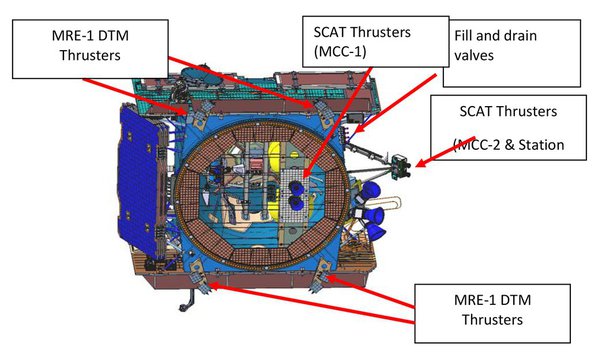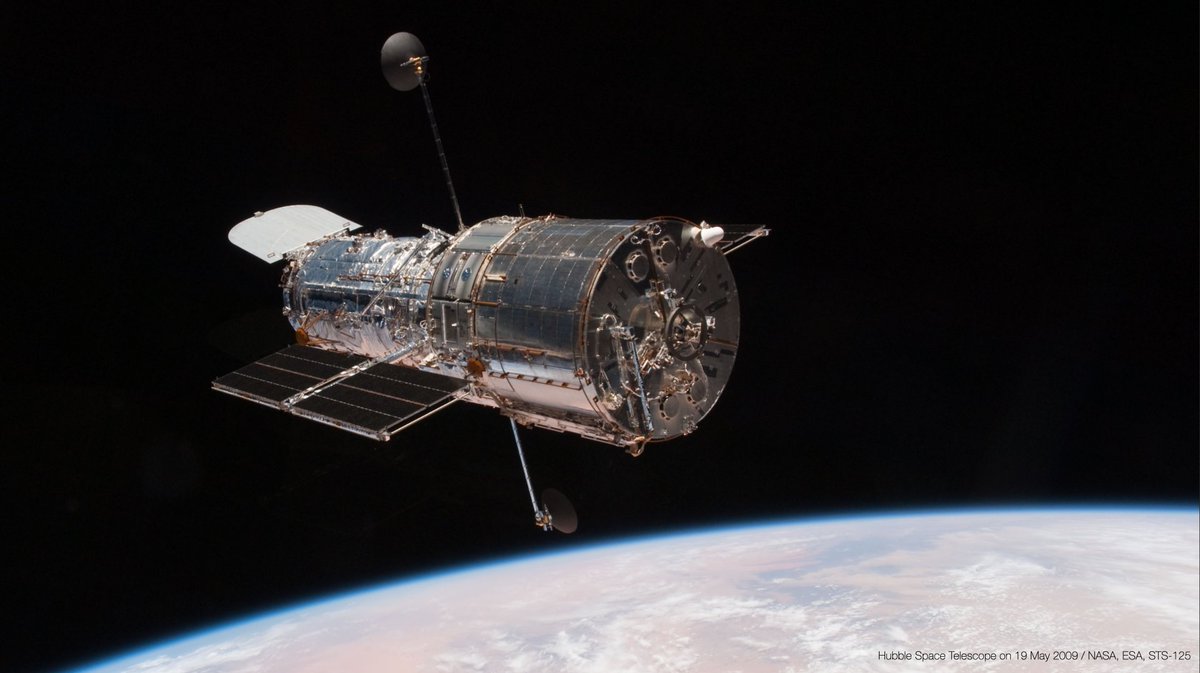
Venus & Mercury, closer to the Sun, orbit more quickly, in 225 & 88 Earth days, respectively.
Mars is further out & takes 687 days to orbit; Jupiter 4332, Saturn 10759, Uranus 30685, & Neptune 60,189 days.
Ditto for non-planets like Pluto. Cough 😳
Image: Wikipedia/WP
18/
Mars is further out & takes 687 days to orbit; Jupiter 4332, Saturn 10759, Uranus 30685, & Neptune 60,189 days.
Ditto for non-planets like Pluto. Cough 😳
Image: Wikipedia/WP
18/
The relationship between the distance of a planet from the Sun & its orbital period was discovered by Johannes Kepler.
His third law says the square of the orbital period of a planet is proportional to the cube of its orbital semi-major axis.
19/
His third law says the square of the orbital period of a planet is proportional to the cube of its orbital semi-major axis.
19/
https://twitter.com/markmccaughrean/status/866657185815818240?s=20
So, if your orbit is a bit further from the Sun than Earth's, you'll orbit a bit more slowly.
So, at 1.5 million km further out than Earth (i.e. 1% larger than Earth's orbit), you'd take 1.5% longer to go around the Sun, i.e. 370.74 days.
20/
So, at 1.5 million km further out than Earth (i.e. 1% larger than Earth's orbit), you'd take 1.5% longer to go around the Sun, i.e. 370.74 days.
20/
So that means you'd fall behind Earth & slowly drift away from it over the years.
Except (& this is what Lagrange found), when you account for Earth's gravity as well, things change – it adds extra pull into the equation.
21/
Except (& this is what Lagrange found), when you account for Earth's gravity as well, things change – it adds extra pull into the equation.
21/
As Kepler would have you drift slowly behind Earth, Earth's gravity pulls you back into line. And if for some reason, you started to drift *ahead* of Earth, the same would happen: Earth's additional gravity would pull you back along the orbit & hold you in place.
22/
22/
Those are the uphill parts of the saddle: it's hard to drift along the orbit from L2.
But if you start falling towards Earth radially, you're in trouble: Earth's gravity gets stronger & pulls you harder. You fall off L2 & towards Earth.
23/
But if you start falling towards Earth radially, you're in trouble: Earth's gravity gets stronger & pulls you harder. You fall off L2 & towards Earth.
23/
Similarly, if you move further away from Earth radially, its gravitational pull gets weaker with distance & you just keep falling away.
That explains the downhill slopes of the saddle at L2, as well as at L1 & L3.
That's why L1, L2, & L3 are not stable equilibria.
24/
That explains the downhill slopes of the saddle at L2, as well as at L1 & L3.
That's why L1, L2, & L3 are not stable equilibria.
24/
But if you can find a way of staying near L2 or L1, then you'll co-orbit the Sun with Earth in 365.25 days & at a nice distance of about 1.5 million kilometres.
Not too close to Earth's heat & not too far to mean low data rates.
25/
Not too close to Earth's heat & not too far to mean low data rates.
25/
Now obviously L1 is no use for #JWST, because it’s 1.5 million km towards the Sun, so will have the hot Sun always on one side & the warm Earth always on the other.
A kind of lopsided toaster.
26/
A kind of lopsided toaster.
26/
L1 is good for solar missions, studying the Sun from an unchanging viewpoint (ISEE-3, SOHO, ACE, Genesis, WIND, Chang'e 5), missions that view Earth (DSCOVR), or just for stability away from Earth (LISA Pathfinder).
27/
27/
But L2 is the site of choice for many astronomy missions, including past ones like WMAP, Herschel, & Planck, present ones like @esagaia & #JWST, & future ones like Euclid, NGRST, Ariel, LiteBIRD, plus as the holding point for Comet Interceptor.
28/
28/
@ESAGaia Keeping both Earth & the Sun on one side of the spacecraft lets them use a sunshield to block the heat, allowing the other side to get very cold & dark.
All the while not too far from Earth, so lots of data can be sent back. For example, #JWST can send 28Mbps from L2.
29/
All the while not too far from Earth, so lots of data can be sent back. For example, #JWST can send 28Mbps from L2.
29/
@ESAGaia But because L2 isn't stable (remember the saddle?), you can't just plonk a spacecraft there.
Instead, you go into an orbit *around* L2. Yes, around an empty point in space, but where gravity, centripetal force, & maths act to create a kind of stealth "Planet Lagrange" 🙂
30/
Instead, you go into an orbit *around* L2. Yes, around an empty point in space, but where gravity, centripetal force, & maths act to create a kind of stealth "Planet Lagrange" 🙂
30/
There are whole families of different orbits which can be used around L2.
For example, Gaia is in a so-called Lissajous orbit, which looks like this as seen from Earth, rising above & falling below the ecliptic, & moving ahead & behind Earth.
esa.int/ESA_Multimedia…
31/
For example, Gaia is in a so-called Lissajous orbit, which looks like this as seen from Earth, rising above & falling below the ecliptic, & moving ahead & behind Earth.
esa.int/ESA_Multimedia…
31/

With the MCC-2 burn, JWST will enter a halo orbit around L2, a special sub-class of Lissajous orbit.
It's ~1.6 million km wide along the Earth orbit direction, but rises & falls ~400,000km out of the plane, & is tilted. Each orbit takes ~6 months.
jwst-docs.stsci.edu/jwst-observato…
32/
It's ~1.6 million km wide along the Earth orbit direction, but rises & falls ~400,000km out of the plane, & is tilted. Each orbit takes ~6 months.
jwst-docs.stsci.edu/jwst-observato…
32/

So, while an object strictly at L2 would always rise to its highest point in the night sky at midnight (think about it 🙂), in reality, #JWST will move around by +/- 30º or so at midnight over the course of six months.
33/
33/
https://twitter.com/tony873004/status/1476299450469392387?s=20
As #JWST moves in its orbit around L2 & Earth's axis tilts during the year, this would make for an interesting artificial analemma, either for optical or radio observers, the latter monitoring the data being beamed back.
Photo: Anthony Ayiomamitis
en.wikipedia.org/wiki/Analemma
34/
Photo: Anthony Ayiomamitis
en.wikipedia.org/wiki/Analemma
34/

Another key aspect of this halo orbit around L2 is the out-of-the-ecliptic part, which ensures that #JWST never experiences an eclipse where Earth blocks the Sun.
As #JWST is solar-powered, this would not be a good thing 😱
35/
As #JWST is solar-powered, this would not be a good thing 😱
35/
Of course, the Sun & Earth are not the only forces acting at L2 in reality: there's also the gravity of the Moon & planets to consider, plus the solar radiation pressure.
These will all act to perturb #JWST's halo orbit & it will need to be adjusted every ~21 days.
36/
These will all act to perturb #JWST's halo orbit & it will need to be adjusted every ~21 days.
36/
This will be done with small SCAT thrusters on #JWST, using a mix of hydrazine & nitrogen tetroxide.
Those are on the hot side of the observatory, to avoid any possible contamination of the optics. That means they can essentially only push #JWST away from Earth.
37/
Those are on the hot side of the observatory, to avoid any possible contamination of the optics. That means they can essentially only push #JWST away from Earth.
37/

Thus to avoid the possibility of accidentally pushing #JWST over the top of the L2 saddle & away from Earth forever (because there are no thrusters on the cold side to push it back), the whole #JWST orbit is slightly biased to stay on the Earth side of the saddle.
38/
38/
Because the orbit is large & the orbital speed around L2 low, only ~1km/s, changes are slow & easily controlled with those thruster burns.
All to keep #JWST where it needs to be, in the Goldilocks spot able to stay cold & deliver lots of science data back home.
39/
All to keep #JWST where it needs to be, in the Goldilocks spot able to stay cold & deliver lots of science data back home.
39/
Which brings us back to MCC-2, the burn that will inject #JWST into that halo orbit around L2 today.
It's a small one, just ~1.5 metres/sec velocity adjustment, using little fuel, similar in some ways to the routine ones that'll come later.
40/
It's a small one, just ~1.5 metres/sec velocity adjustment, using little fuel, similar in some ways to the routine ones that'll come later.
40/
https://twitter.com/tony873004/status/1485493212202500096?s=20
But once the MCC-2 burn is complete, I think it’ll be fair to say that we’re “home”, & that another major step will have been taken on #JWST’s journey, a step closer to the science we’ve all been waiting for so long.
41/
41/
There’s still much work to be done by the teams, aligning, focussing, & phasing the optics, cooling the instruments & commissioning them, & first science won’t come until June.
But still, huge positive progress so far for the @nasa/@esa/@csa_asc #JWST 🙇♂️🖖🤘
42/42
But still, huge positive progress so far for the @nasa/@esa/@csa_asc #JWST 🙇♂️🖖🤘
42/42
@NASA @esa @csa_asc Coda: I also promised a "when" at the start of this thread.
MCC-2 is due to take place at 14:00 Baltimore time, so in about 5 minutes time 🙂
There's a press event an hour later to get the latest news: nasa.gov/press-release/…
MCC-2 is due to take place at 14:00 Baltimore time, so in about 5 minutes time 🙂
There's a press event an hour later to get the latest news: nasa.gov/press-release/…
This should continue the broken thread until the end (42 tweets in all), if I’m lucky 🤞
https://twitter.com/markmccaughrean/status/1485669788936556544
• • •
Missing some Tweet in this thread? You can try to
force a refresh







